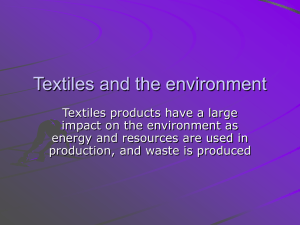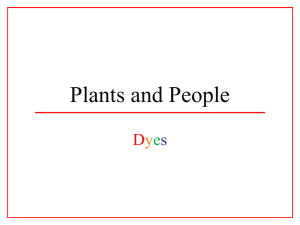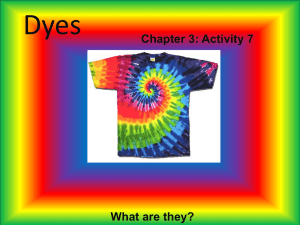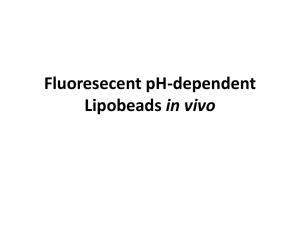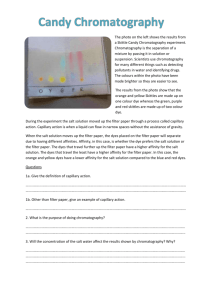Natural Dyeing of Cotton Fabrics with Dyes
advertisement
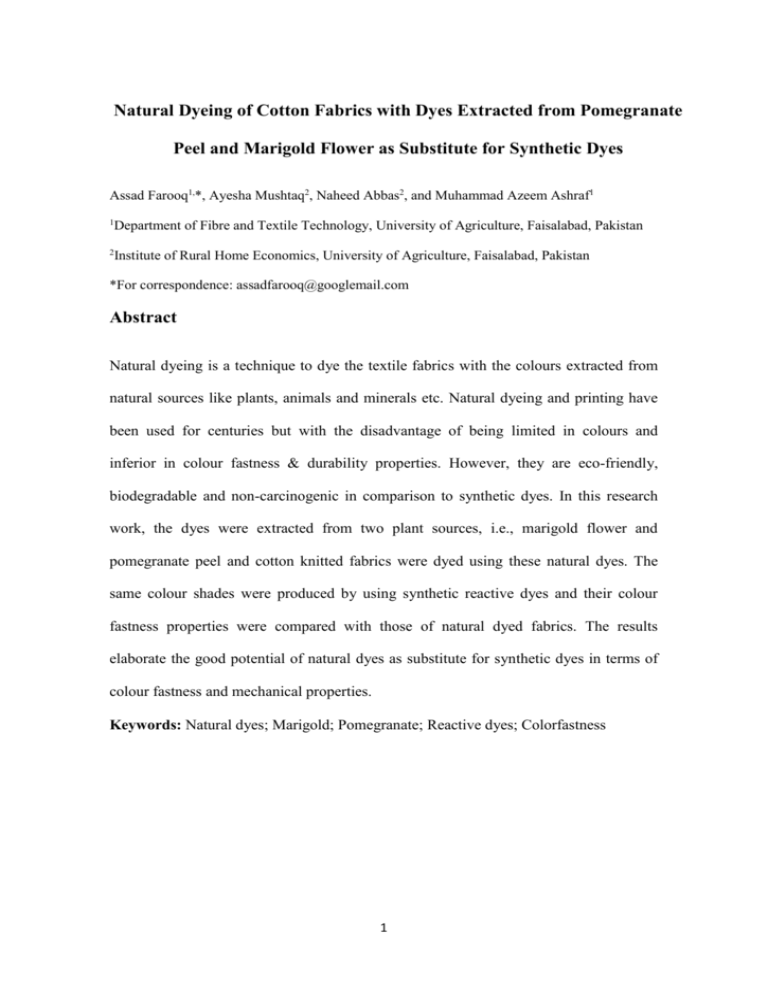
Natural Dyeing of Cotton Fabrics with Dyes Extracted from Pomegranate Peel and Marigold Flower as Substitute for Synthetic Dyes Assad Farooq1,*, Ayesha Mushtaq2, Naheed Abbas2, and Muhammad Azeem Ashraf1 1 Department of Fibre and Textile Technology, University of Agriculture, Faisalabad, Pakistan 2 Institute of Rural Home Economics, University of Agriculture, Faisalabad, Pakistan *For correspondence: assadfarooq@googlemail.com Abstract Natural dyeing is a technique to dye the textile fabrics with the colours extracted from natural sources like plants, animals and minerals etc. Natural dyeing and printing have been used for centuries but with the disadvantage of being limited in colours and inferior in colour fastness & durability properties. However, they are eco-friendly, biodegradable and non-carcinogenic in comparison to synthetic dyes. In this research work, the dyes were extracted from two plant sources, i.e., marigold flower and pomegranate peel and cotton knitted fabrics were dyed using these natural dyes. The same colour shades were produced by using synthetic reactive dyes and their colour fastness properties were compared with those of natural dyed fabrics. The results elaborate the good potential of natural dyes as substitute for synthetic dyes in terms of colour fastness and mechanical properties. Keywords: Natural dyes; Marigold; Pomegranate; Reactive dyes; Colorfastness 1 Introduction Synthetic dyes are manufactured from aromatic compounds acquired from coal tar or petroleum. The synthetic dyeing industry is growing at very fast rate decreasing the use of natural dyes. The demand for the synthetic dyes is high because it satisfies dyers demand as it has simple and reproducible application processes and they can also be manufactured at reasonable price (Sengupta and Singh, 2003). The colour fastness of synthetic dyes is high because dye is very strongly bound to the fabric and it does not detach easily. Synthetic dyes have a variety of colours according to the demand of consumers but these dyes are environmentally unfriendly because their production and application requires strong acids, alkalies, solvents, toxic amines, high temperatures and heavy metal catalysts (Hunger, 2003). These dyes are toxic and hazardous in nature. Disposal of hazardous wastes of synthetic dyes is a major environmental and economic challenge. Natural dyes are non-toxic and do not create environmental problems due to their biodegradable nature (Kulkarni et al. 2011). Demand of natural dyes is increasing continuously (Samanta and Agarwal, 2009) as their production and application does not require strong acids and alkalies (Bhuyan et al., 2004). In addition of their environmental friendly nature many natural dyes have anti allergic and deodorizing properties (Lee et al, 2010). The use of natural dyes has been limited to small scale dyers and craftsman (Bechtold and Mussak, 2009). However many dyers and exporters have started to finding possibilities of using natural dyes on regular use as substitute of synthetic dyes to overcome the problems of pollution caused by synthetic dyes (Glover and Pierce, 1993). 2 Natural dyes are obtained naturally from vegetable or animal materials without applying any chemical procedure. Such examples of natural dyes obtained from plant source are marigold and pomegranate. Among many cultivated varieties of marigold Tagetes erecta and Tagetes patula are most important for colouration purpose. Marigold plants are chubby and can grow upto 60 cm tall (Bosma et al, 2003; Heo et al, 2004). Lutein (C40H56O2) is a natural dye which belongs to the carotenoid family (Pant, 1998) can be obtained from marigold flowers. Lutein and its isomer xanthophylls present in high concentration in marigold flowers than other plants (Verghese, 1998). The xanthophylls are widely used in food colours due to their natural yellow to red colour. Pomegranate (Punicagrantum) belongs to the family Punicacea is native of Persia (Goodarzian and Ekrami, 2010) but grows in most warm countries. The dried and powdered pomegranate rind has been used from ancient times as a natural colouring agent. Granatonine is the main colouring agent in pomegranate peel present in alkaloid form N-methyl granatonine. Keeping in view current scenario of environmental consciousness the present study was planned to compare the characteristics of fabrics dyed with two natural dyes marigold (Tagetes Erecta) & pomegranate (Punicagrantum) and synthetic reactive dyes. Materials and Methods Extraction of Natural Dyes The extraction of natural dye from the marigold flower and pomegranate peel was conducted with distilled water using soxhlet apparatus with material to liquor ratio1:20. The extractions were carried out at temperature 1000C for 90 minutes. 3 Dyeing with Natural Dyes The samples of knitted cotton fabric, weighing 10g each, were dyed separately with the extracts of natural dyes at liquor ratio of 30:1. Knitted cotton fabrics were dyed by exhaust method in lab scale HT dyeing machine at 60°C, 80°C and 100°C to study the effect of temperature. In order to observe the effect of dyeing time dyeing was carried out for 30, 60 and 90 min. Dyeing with Synthetic Dyes The dyeing of cotton fabrics with synthetic dyes was done by using appropriate amount of reactive dyes required to produce same shades as that of natural dyes. Dyeing was done for 30, 60 and 90 min at 60°C, 80°C and 100°C to study the effect of time and temperature using liquor ratio of 15:1. Sodium carbonate 20 g/l and sodium sulphate 50 g/l were added as auxiliaries. After dyeing all dyed samples were thoroughly soaped using 2 g/l nonionic detergent (Triton X-100). The shade of reactive dyes was matched with marigold and pomegranate dye using Datacolour SF 600 spectrophotometer. Fabric Evaluation The tensile strength of fabrics was determined according to ASTM standard test method D-5034.Washing fastness of the samples was tested according to ISO 105-CO3 method. The samples were washed in standard soap solution at 60°C for 30 minutes. Dry and wet rubbing fastness of the dyed samples was tested according to ISO 105-X12 method. 4 Results and Discussions Tensile Strength of Fabrics The results of tensile strength of fabrics dyed with pomegranate dye and synthetic reactive dyes at different temperatures and time intervals are compared in Fig 1. The Fig 1 shows an overall decreasing trend with the increase in dyeing temperature and time intervals both for synthetic and natural dyes. This may be due to fibre and dyes degradation at high temperatures and for longer time intervals. The other interesting fact is that the fabrics dyed with pomegranate dye have less tensile strength as compared with that of synthetic dyes. This can be attributed to the degradation of pomegranate dye at high temperatures and at longer time intervals. The comparison of tensile strength of fabrics dyed with marigold dye and with synthetic reactive dyes of same shade is presented in Fig 2. The graph shows that as an overall trend, the fabrics dyed with marigold dye show higher tensile strength as compared to that of the fabric dyed with synthetic dyes. This fact is eminent at all-time durations and temperatures. This implies that marigold dyes has caused less weakening of the fibre structures as compared to synthetic reactive dyes. Similarly, the increase in dyeing time and temperature has negatively affected the tensile strength of the fabrics, which is true for both natural and synthetic dyes. From the results, it can be inferred that dyeing with natural marigold dyes has less affect on tensile strength of the fabrics as compared with its synthetic substitute, whereas this trend is reverse for natural pomegranate dyes. 5 Rubbing Fastness The results pertaining to dry and wet rubbing fastness for the fabrics dyed with natural pomegranate dye as well as synthetic dye are presented in Table 1. In case of fabrics dyed with pomegranate dye, dry rubbing fastness was observed as ‘very good (4)’ at 60oC and 80oC, however this rating falls to ‘good to very good (3-4)’. While in case of wet rubbing the most of temperature and time intervals produce ‘good (3)’ ratings. In case of fabrics dyed with synthetic reactive dyes dry rubbing fastness was mostly very good to excellent(4-5) at 60oC and 80oC and very good (4) at 100oC . However, in case of wet rubbing mostly very good (4) rating was observed for all time and temperatures. For both dyes natural and synthetic, rubbing fastness rating was decreased by increasing the duration of dyeing and temperature. This may be due to decomposition of dyes at higher temperatures for prolonged dyeing period (Nagia and El-Mohamedy, 2007) which results in easy removal of dye in effect of rubbing treatment. Mostly fabrics dyed with natural dye have lower rating than synthetic reactive dyes due to their weak bonding with fibres, but some samples have shown equal rubbing fastness to synthetic dyes. The results pertaining to dry and wet rubbing fastness for the fabrics dyed with natural marigold dye as well as synthetic dye are presented in Table 2. Both for dry and wet rubbing the fabrics dyed with marigold dye have shown inferior performance in comparison with synthetic dyes. The natural dye detaches from fabric in result of wear due to breakage of weak dyefibre bond (Jothi, 2008). The ratings for synthetic dyes range from ‘very good to excellent (4-5)’ to ‘very good (4)’, whereas that of marigold dyes ranges from ‘good 6 (3)’ to ‘very good (4)’. The overall decrease in rating for wet rubbing corresponds to the weak bonding the natural dyes with fibres. Washing Fastness The results pertaining washing fastness for the fabrics dyed with natural pomegranate dye as well as synthetic dye of same shade are presented in Table 3. In case of fabrics dyed with pomegranate dye washing fastness was mostly ‘very good (4)’ for 60min and ‘good to very good (4)’ for 80 &100 min dyeing durations while in case of dyeing with synthetic reactive dyes, washing fastness was mostly ‘very good (4)’ for all dyeing durations. It can be observed from Table 3 that fabrics dyed with pomegranate dye for 60 min duration have comparable results with fabrics dyed with synthetic reactive dyes. The results of washing fastness of fabrics dyed with marigold dye and synthetic reactive dye of same shade presented in Table 4 shows that fabrics dyed with synthetic reactive dyes have shown higher grey scale rating of rubbing fastness. The very good washing fastness of synthetic reactive dyed samples was due to strong covalent bond formation between dye and fabric. But fabrics dyed with pomegranate dye for 60 min duration also have comparable washing fastness to synthetic reactive dye. It can be observed from Table 3 and Table 4 that fabrics dyed with pomegranate dye have shown higher washing fastness rating than fabrics dyed with marigold dye. It may be due stronger bonding of pomegranate dye with the cotton fibres than marigold dye. 7 Conclusions The following conclusions were drawn from the present research work. Fabrics dyed with natural marigold dye have shown higher tensile strength than synthetic reactive dyes while pomegranate dye reduced fabric strength in comparison with synthetic dyes. Fabrics dyed with pomegranate dye have shown better performance regarding colour fastness to rubbing and washing than marigold dyed Fabrics. Marigold petals and pomegranate peel can be used as a substitute of synthetic reactive dyes for dyeing of cotton fabric. These dyes have comparable colour fastness properties with synthetic dyes, but have major advantage of being ecofriendly and can help to minimize the problems of effluents from synthetic dyes. 8 References Bechtold, T. and R. Mussak, 2009. Handbook of natural colorants, John Wiley & Sons, West Sussex Bhuyan, R., C. N. Saikia and K. K. Das, 2004. Extraction and identification of colour components from the barks of Mimusops elengi and Terminalia arjuna and evaluation of their dyeing characteristics on wool. Indian Journal of Fibre & Textile Research, 29: 477-479 Bosma, T. L., J. M. Dole and N. O. Maness, 2003. Optimizing marigold (Tagetes erecta L.) petal and pigment yield. Crop Science, 43: 2118-2124 Glover, B. and J. H. Pierce, 1993. Are natural colorants good for your health? Journal of the Society of Dyers and Colourists, 109: 5-7 Goodarzian, H. and E. Ekrami, 2010. Wool dyeing with extracted dye from pomegranate (Punica Granatum) peel. World Applied Science Journal, 8: 13871389 Heo, B. G., K. S. Kim, H. G. Jang, Y. J. Park, C. E. Song and Y. K. Yoo,2004. Natural dye on dry flower, the Laqurusovatus using the extract isolated from marigold. Korean Journal of Horticultural Science and Technology, 3: 119-124 Hunger, K., 2003. Industrial Dyes Chemistry, Properties, Applications, Wiley-VCH Verlag GmbH & Co. KGaA, Weinheim Jothi, D., 2008. Extraction of natural dyes from African marigold flower (TagetesEreecta L) for textile coloration. AUTEX Research Journal, 8: 49-53 Kulkarni, S. S., A. V. Gokhale, U. M. Bodake and G. R. Pathade, 2011. Cotton dyeing with natural dye extracted from pomegranate (punicagranatum) peel. Universal Journal of Environmental Research and Technology, 1: 135-139 9 Lee, Y. H., E. K. Hwang, Y. J. Jung, S. K. Do and H. D. Kim, 2010. Dyeing and deodorizing properties of cotton, silk, wool fabrics dyed with Amur Corktree, Dryopteriscrassirhizoma, Chrysanthemum boreale, Artemisia extracts. Journal of Applied Polymer Science, 115: 2246-2253 Nagia, F. A. and R. S. R. El-Mohamedy, 2007. Dyeing of wool with natural anthraquinone dyes from fusariumoxysporum. Dyes and Pigments, 75: 550–555 Pant, S., 1998. Oak bark, Abican marigold & Kerala flowers; Sources of dyes for dyeing wool. Textile Dyer & Printer, 31: 11-15 Samanta, A. K. and P. Agarwal, 2009. Application of natural dyes on textiles. Indian Journal of Fibre & Textile Research, 34: 384-399 Sengupta, S. and B. R. Singh, 2003. Natural, “green” dyes for the textile industry. Technical Report No 57, University of Massachusetts Lowell Verghese, J., 1998. Focus on xanthophylls from Tagetes Erecta L the giant natural complex-I. Indian Spices, 33: 8-13 10 Tensile Strength (Kg) 20 Pomegranate Synthetic 15 10 5 0 60 °C 80 °C 100 °C 60 °C 80 °C 100 °C 60 min 80 min 60 °C 80 °C 100 °C 100 min Fig. 1: Comparison of tensile strength of fabrics dyed with pomegranate dye and with synthetic reactive dyes Tensile Strength (Kg) 20 Marigold Synthetic 15 10 5 0 60 °C 80 °C 100 °C 60 °C 80 °C 100 °C 60 min 80 min 60 °C 80 °C 100 °C 100 min Fig. 2: Comparison of tensile strength of fabrics dyed with marigold dye and with synthetic reactive dyes 11 Table 1: Rubbing fastness of fabrics dyed with pomegranate dye and with synthetic reactive dyes Rubbing fastness Time (min) 60 80 100 Temperature (˚C) Pomegranate Synthetic Dry Wet Dry Wet 60 4 3 4-5 4 80 4 3-4 4-5 4 100 4 3-4 4 4 60 4 3 4-5 4 80 4 3-4 4 4 100 4 3 4 3-4 60 3-4 3 4-5 4 80 3-4 3 4 3-4 100 3-4 3 4 3-4 Excellent =5, Very Good = 4, Good = 3, Ordinary = 2, Poor = 1 12 Table 2: Rubbing fastness of fabrics dyed with marigold dye and with synthetic reactive dyes Rubbing fastness Time (min) 60 80 100 Temperature (˚C) Marigold Synthetic Dry Wet Dry Wet 60 3-4 3 4-5 4 80 4 3 4 4 100 4 3-4 4 3-4 60 3-4 3 4-5 4 80 3-4 3 4 4 100 3-4 3-4 4 3-4 60 3 3 4 3-4 80 3 3 4 3-4 100 3 3 4 3-4 Excellent =5, Very Good = 4, Good = 3, Ordinary = 2, Poor = 1 13 Table 3: Washing fastness of fabrics dyed with pomegranate dye and with synthetic reactive dyes Washing fastness Time (min) 60 80 100 Temperature (˚C) Pomegranate Synthetic 60 4 4-5 80 4 4 100 4 4 60 3-4 4-5 80 4 4 100 3-4 4 60 3-4 4 80 3-4 4 100 3-4 4 Excellent =5, Very Good = 4, Good = 3, Ordinary = 2, Poor = 1 14 Table 4: Washing fastness of fabrics dyed with marigold dye and with synthetic reactive dyes Washing fastness Time (min) 60 80 100 Temperature (˚C) Marigold Synthetic 60 3 4 80 3-4 4-5 100 4 4 60 3-4 4-5 80 3-4 4-5 100 3 4 60 3-4 4 80 3 4 100 3 3-4 Excellent =5, Very Good = 4, Good = 3, Ordinary = 2, Poor = 1 15

